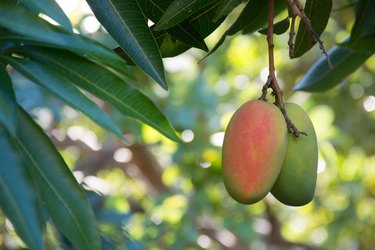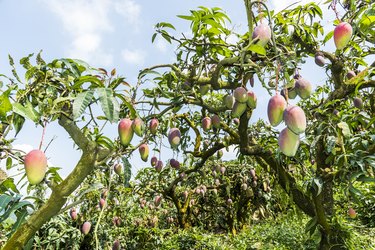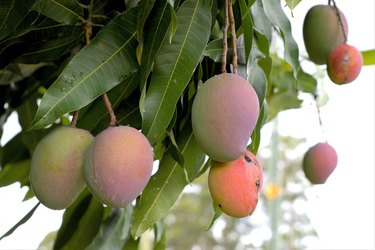
One of the best fruit trees producing the most exotic summer fruits is the mango (Mangifera indica). Living in a tropical or sub-tropical climate hosting a mango tree, whether in-ground or in a container, gives you entrée into a world of sublime-tasting jams, jellies, flavor enhancers, curries, compotes and fillings. Mangos aren't fussy regarding the type of soil they are grown in as long as the weather stays warm and rarely dips below 40 degrees Fahrenheit. The best producing mango trees are grown in the lowlands of U.S. Department of Agriculture hardiness zones 10 and 11 and can thrive in the southernmost portion of zone 9 if given protection.
Growing Mangos Successfully
Video of the Day
The national fruit of India, Pakistan and the Philippines, with the lowlands of those countries producing the best soil for a mango tree, the mango originated in southern India over 4,000 years ago. The fruit didn't reach the Americas until the 1800s. While Asia still grows the largest percentage of mangos, production also is centered in Florida, Hawaii, California, Puerto Rico, Mexico, Haiti and South America, with Mexico being the largest supplier of the fruit to the United States. A relative of the cashew and pistachio, its orange, pineapple and peach flavor has rendered its nickname "The King of Fruit."
Video of the Day
While weather is the most decisive factor in the successful growth of the mango tree, soil structure is probably the least important factor. Mangos are not fussy as to the content of the soil they are grown in as long as it's well-balanced and well-draining. Planting trees on a slope encourages growth, as the water table doesn't hold the moisture and the roots won't get waterlogged.
The Best Soil for the Mango Tree

Clay, sand and loam are all good soils for growing mangos, as long as the trees are planted deeply and the roots aren't over-watered. A range of pH between 5.5 and 7.5 will successfully produce mangos; if your soil is outside those parameters, add hydrated lime to increase the pH or add sulfur to reduce it. If you are newly planting a mango tree, add compost to the planting spot or the soil in a container, and include a circle of mulch spread around the drip line but away from the trunk to benefit the tree.
Fall and winter are dormant times for the mango, so fertilizer is not required, but during the growing season provide a dose of organic fertilizer high in nitrogen three times during the season. Don't over-fertilize young trees. Fish emulsion is a good addition to the fertilizing regimen; avoid any product that contains salt.
Choosing the Right Potting Mix for Mangos

When planting a mango tree, whether from seed which takes numerous years to produce fruit, or from a grafted sapling, choosing the right potting mix is essential to encouraging fruiting. Be sure to know the variety of mango you have purchased, as there are specific varieties that do well in the confined spaces of a container. Before planting, spread a layer of broken pottery and a layer of gravel in the bottom of the container to aid drainage. Be sure drain holes have been drilled into the bottom of the container, and place it in a location where water doesn't pool.
While mango trees planted in the ground don't require a lot of water, don't let container-grown mangos get dry. Cut back on the water as soon as the tree starts to produce, and supplement the soil frequently with organic potting mix with some occasional river sand.